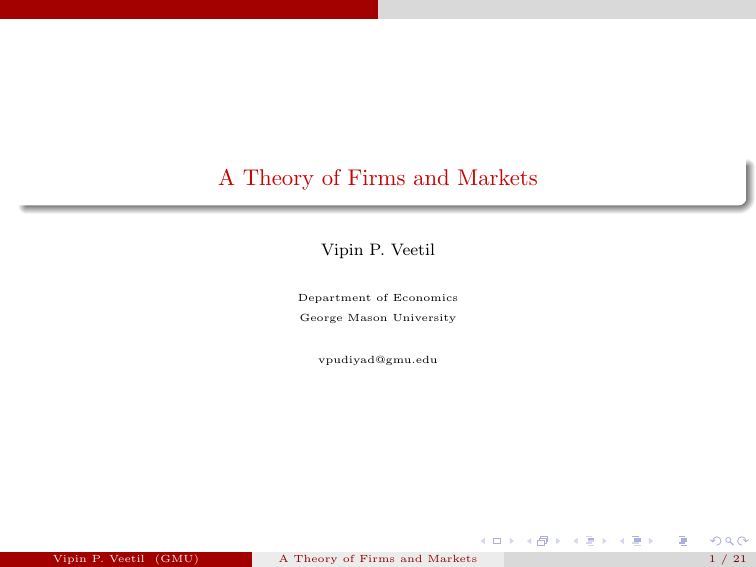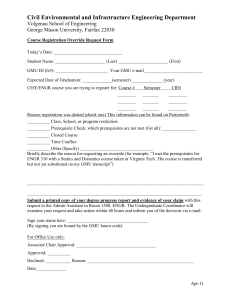A Theory of Firms and Markets Vipin P. Veetil Department of Economics
advertisement

A Theory of Firms and Markets
Vipin P. Veetil
Department of Economics
George Mason University
vpudiyad@gmu.edu
Vipin P. Veetil (GMU)
A Theory of Firms and Markets
1 / 21
Overview
1
The Problem
2
Related Literature
3
The Model
4
Results
5
Future Work
Vipin P. Veetil (GMU)
A Theory of Firms and Markets
2 / 21
The Problem
Coase’s Question
“In view of the fact that while economists treat the
price mechanism as a co-ordinating instrument, they
also admit the co-ordinating function of the
“entrepreneur,” it is surely important to enquire why
co-ordination is the work of the price mechanism in one
case and of the entrepreneur in another.” - Coase
(1937)
Vipin P. Veetil (GMU)
A Theory of Firms and Markets
3 / 21
Related Literature
Theories of Firm and Markets
Team Production (Alchian and Demsetz 1972) and Asset Specificity (Williamson 1975)
Vipin P. Veetil (GMU)
A Theory of Firms and Markets
4 / 21
Related Literature
Theories of Firm and Markets
Team Production (Alchian and Demsetz 1972) and Asset Specificity (Williamson 1975)
Markets too can solve problems associated with opportunistic behavior: Folk Theorem
(Hart 1989)
Vipin P. Veetil (GMU)
A Theory of Firms and Markets
4 / 21
Related Literature
Theories of Firm and Markets
Team Production (Alchian and Demsetz 1972) and Asset Specificity (Williamson 1975)
Markets too can solve problems associated with opportunistic behavior: Folk Theorem
(Hart 1989)
Markets too may be thought of as team production (Young 1928, Arrow 1994)
Vipin P. Veetil (GMU)
A Theory of Firms and Markets
4 / 21
Related Literature
What is the basic economic problem?
“...a problem of the utilization of knowledge not given
to anyone in its totality” - Hayek (1945)
Vipin P. Veetil (GMU)
A Theory of Firms and Markets
5 / 21
Related Literature
Mechanisms for solving the basic economic problem
Firms
Vipin P. Veetil (GMU)
A Theory of Firms and Markets
6 / 21
Related Literature
Mechanisms for solving the basic economic problem
Firms
Centralize knowledge
Vipin P. Veetil (GMU)
A Theory of Firms and Markets
6 / 21
Related Literature
Mechanisms for solving the basic economic problem
Firms
Centralize knowledge
Compute plans
Vipin P. Veetil (GMU)
A Theory of Firms and Markets
6 / 21
Related Literature
Mechanisms for solving the basic economic problem
Firms
Centralize knowledge
Compute plans
Markets
Vipin P. Veetil (GMU)
A Theory of Firms and Markets
6 / 21
Related Literature
Mechanisms for solving the basic economic problem
Firms
Centralize knowledge
Compute plans
Markets
Leave knowledge where it is
Vipin P. Veetil (GMU)
A Theory of Firms and Markets
6 / 21
Related Literature
Mechanisms for solving the basic economic problem
Firms
Centralize knowledge
Compute plans
Markets
Leave knowledge where it is
Decentralized and parallel computation of plans
Vipin P. Veetil (GMU)
A Theory of Firms and Markets
6 / 21
Related Literature
Mechanisms for solving the basic economic problem
Firms
Centralize knowledge
Compute plans
Markets
Leave knowledge where it is
Decentralized and parallel computation of plans
Example: Awesome Ketchup and Great Tomatoes
Vipin P. Veetil (GMU)
A Theory of Firms and Markets
6 / 21
Related Literature
Properties of Dispersed Knowledge
Dynamism (Hayek 1945)
Vipin P. Veetil (GMU)
A Theory of Firms and Markets
7 / 21
Related Literature
Properties of Dispersed Knowledge
Dynamism (Hayek 1945)
How frequently does knowledge change?
Vipin P. Veetil (GMU)
A Theory of Firms and Markets
7 / 21
Related Literature
Properties of Dispersed Knowledge
Dynamism (Hayek 1945)
How frequently does knowledge change?
Tacitness (Polyani 1966)
Vipin P. Veetil (GMU)
A Theory of Firms and Markets
7 / 21
Related Literature
Properties of Dispersed Knowledge
Dynamism (Hayek 1945)
How frequently does knowledge change?
Tacitness (Polyani 1966)
How easy is it to communicate knowledge?
Vipin P. Veetil (GMU)
A Theory of Firms and Markets
7 / 21
Related Literature
Relative cost of using firms and markets
Firm
Vipin P. Veetil (GMU)
A Theory of Firms and Markets
8 / 21
Related Literature
Relative cost of using firms and markets
Firm
Lower Pareto Efficiency than market
Vipin P. Veetil (GMU)
A Theory of Firms and Markets
8 / 21
Related Literature
Relative cost of using firms and markets
Firm
Lower Pareto Efficiency than market
Market
Vipin P. Veetil (GMU)
A Theory of Firms and Markets
8 / 21
Related Literature
Relative cost of using firms and markets
Firm
Lower Pareto Efficiency than market
Market
Transaction Cost
Vipin P. Veetil (GMU)
A Theory of Firms and Markets
8 / 21
Related Literature
Result
The greater the dynamism and tacitiness of knowledge, the lower the relative cost of the
market mechanism
Vipin P. Veetil (GMU)
A Theory of Firms and Markets
9 / 21
The Model
Coordination Problem
N agents, N = 10, 000
Vipin P. Veetil (GMU)
A Theory of Firms and Markets
10 / 21
The Model
Coordination Problem
N agents, N = 10, 000
Each agent begins with an endowment of S goods, S = 2
Vipin P. Veetil (GMU)
A Theory of Firms and Markets
10 / 21
The Model
Coordination Problem
N agents, N = 10, 000
Each agent begins with an endowment of S goods, S = 2
U = xy
Vipin P. Veetil (GMU)
A Theory of Firms and Markets
10 / 21
The Model
Coordination Problem
N agents, N = 10, 000
Each agent begins with an endowment of S goods, S = 2
U = xy
Initial endowment is not Pareto Efficient, {0, 2} or {2, 0}
Vipin P. Veetil (GMU)
A Theory of Firms and Markets
10 / 21
The Model
Coordination Problem
N agents, N = 10, 000
Each agent begins with an endowment of S goods, S = 2
U = xy
Initial endowment is not Pareto Efficient, {0, 2} or {2, 0}
Compare a market and a firm as two ways of reallocating goods
Vipin P. Veetil (GMU)
A Theory of Firms and Markets
10 / 21
The Model
Market
Vipin P. Veetil (GMU)
A Theory of Firms and Markets
11 / 21
The Model
Market
k−lateral exchange (Uzawa 1962; Axtell 2003)
Vipin P. Veetil (GMU)
A Theory of Firms and Markets
12 / 21
The Model
Market
k−lateral exchange (Uzawa 1962; Axtell 2003)
Special case: Edgeworth barter process with two goods
Vipin P. Veetil (GMU)
A Theory of Firms and Markets
12 / 21
The Model
Market
k−lateral exchange (Uzawa 1962; Axtell 2003)
Special case: Edgeworth barter process with two goods
Parallel and decentralized computation
Vipin P. Veetil (GMU)
A Theory of Firms and Markets
12 / 21
The Model
Market
k−lateral exchange (Uzawa 1962; Axtell 2003)
Special case: Edgeworth barter process with two goods
Parallel and decentralized computation
Exchange ratio fixed at unity
Vipin P. Veetil (GMU)
A Theory of Firms and Markets
12 / 21
The Model
Market
k−lateral exchange (Uzawa 1962; Axtell 2003)
Special case: Edgeworth barter process with two goods
Parallel and decentralized computation
Exchange ratio fixed at unity
Transaction cost = number of failed and successful transactions
Vipin P. Veetil (GMU)
A Theory of Firms and Markets
12 / 21
The Model
Market
k−lateral exchange (Uzawa 1962; Axtell 2003)
Special case: Edgeworth barter process with two goods
Parallel and decentralized computation
Exchange ratio fixed at unity
Transaction cost = number of failed and successful transactions
10,000 agents
Vipin P. Veetil (GMU)
A Theory of Firms and Markets
12 / 21
The Model
Firm
Vipin P. Veetil (GMU)
A Theory of Firms and Markets
13 / 21
The Model
Firm
‘Entrepreneur-coordinator’
Vipin P. Veetil (GMU)
A Theory of Firms and Markets
14 / 21
The Model
Firm
‘Entrepreneur-coordinator’
10,000 agents
Vipin P. Veetil (GMU)
A Theory of Firms and Markets
14 / 21
The Model
Firm
‘Entrepreneur-coordinator’
10,000 agents
Short-firm, Hierarchy = 2
Vipin P. Veetil (GMU)
A Theory of Firms and Markets
14 / 21
The Model
Firm
‘Entrepreneur-coordinator’
10,000 agents
Short-firm, Hierarchy = 2
Tall firm, Hierarchy = 10
Vipin P. Veetil (GMU)
A Theory of Firms and Markets
14 / 21
The Model
Dynamism and Tacitness
Dynamism, d
Vipin P. Veetil (GMU)
A Theory of Firms and Markets
15 / 21
The Model
Dynamism and Tacitness
Dynamism, d
Endowment changes every time step
Vipin P. Veetil (GMU)
A Theory of Firms and Markets
15 / 21
The Model
Dynamism and Tacitness
Dynamism, d
Endowment changes every time step
d ∈ (0, 1), proportion of agents whose endowments change
Vipin P. Veetil (GMU)
A Theory of Firms and Markets
15 / 21
The Model
Dynamism and Tacitness
Dynamism, d
Endowment changes every time step
d ∈ (0, 1), proportion of agents whose endowments change
Tacitness, t
Vipin P. Veetil (GMU)
A Theory of Firms and Markets
15 / 21
The Model
Dynamism and Tacitness
Dynamism, d
Endowment changes every time step
d ∈ (0, 1), proportion of agents whose endowments change
Tacitness, t
Errors in communicating endowment to ‘entrepreneur-coordinator’
Vipin P. Veetil (GMU)
A Theory of Firms and Markets
15 / 21
The Model
Dynamism and Tacitness
Dynamism, d
Endowment changes every time step
d ∈ (0, 1), proportion of agents whose endowments change
Tacitness, t
Errors in communicating endowment to ‘entrepreneur-coordinator’
t ∈ (0, 1), probability of error in every instance of communication
Vipin P. Veetil (GMU)
A Theory of Firms and Markets
15 / 21
Results
Efficiency
Vipin P. Veetil (GMU)
A Theory of Firms and Markets
16 / 21
Results
Transactions Cost
Vipin P. Veetil (GMU)
A Theory of Firms and Markets
17 / 21
Results
Summary of Results
Dynamic knowledge: with sufficient transactions markets reach higher efficiency than
firms. Hierarchy dampens the impact of dynamic knowledge on firms.
Vipin P. Veetil (GMU)
A Theory of Firms and Markets
18 / 21
Results
Summary of Results
Dynamic knowledge: with sufficient transactions markets reach higher efficiency than
firms. Hierarchy dampens the impact of dynamic knowledge on firms.
Tacit knowledge: with sufficient transactions markets reach higher efficiency than firms.
Hierarchy amplifies the impact of tacit knowledge on firms.
Vipin P. Veetil (GMU)
A Theory of Firms and Markets
18 / 21
Results
Summary of Results
Dynamic knowledge: with sufficient transactions markets reach higher efficiency than
firms. Hierarchy dampens the impact of dynamic knowledge on firms.
Tacit knowledge: with sufficient transactions markets reach higher efficiency than firms.
Hierarchy amplifies the impact of tacit knowledge on firms.
Markets are a more optimal arrangement than firms if the gains in allocative efficiency
exceed transaction costs
Vipin P. Veetil (GMU)
A Theory of Firms and Markets
18 / 21
Results
The Architecture of an Economic System
Vipin P. Veetil (GMU)
A Theory of Firms and Markets
19 / 21
Future Work
Future Work
Endogenize price formation
Vipin P. Veetil (GMU)
A Theory of Firms and Markets
20 / 21
Future Work
Future Work
Endogenize price formation
Study firm structures
Vipin P. Veetil (GMU)
A Theory of Firms and Markets
20 / 21
Future Work
Future Work
Endogenize price formation
Study firm structures
Study market structures: why is the NYSE different from New York’s Fish market?
Vipin P. Veetil (GMU)
A Theory of Firms and Markets
20 / 21
Future Work
Future Work
Endogenize price formation
Study firm structures
Study market structures: why is the NYSE different from New York’s Fish market?
What factors determine whether and how well an economy ‘finds’/‘computes’ optimal
architecture?
Vipin P. Veetil (GMU)
A Theory of Firms and Markets
20 / 21
Future Work
Future Work
Endogenize price formation
Study firm structures
Study market structures: why is the NYSE different from New York’s Fish market?
What factors determine whether and how well an economy ‘finds’/‘computes’ optimal
architecture?
Incorporate the computational complexity of problem faced by entrepreneur-coordinator
Vipin P. Veetil (GMU)
A Theory of Firms and Markets
20 / 21
Future Work
Vipin P. Veetil (GMU)
A Theory of Firms and Markets
21 / 21






